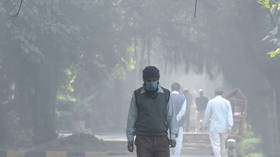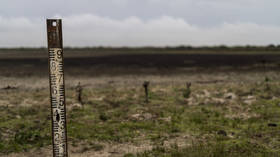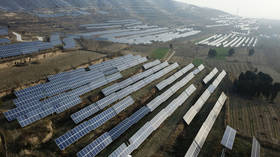Why Indians face breathing toxic air for years to come

A new report on global air quality illustrates an increasing disparity between residents of richer cities compared to those in the developing and least developed nations over the past year.
The report was published by Switzerland’s IQAir, an air quality technology company specializing in protection against airborne pollutants, developing air quality monitoring, and air cleaning products. The annual survey used 30,000 ground level sensors in more than 7,000 cities in over 130 countries around the world. The researchers measured the concentration of fine particulate matter with diameters of up to 2.5 microns, known as PM2.5, which is considered to be one of the most hazardous pollutants as it may be able to enter the bloodstream. To compile the rankings in the report, the data was averaged over the year and weighted by country or city population.
India’s New Delhi and Iraq’s Baghdad were among the top three most-polluted capital cities, where pollutants were considered to be around 18 times higher than the World Health Organization’s (WHO) recommendations. N’Djamena, the capital of the landlocked African nation of Chad and one of the poorest countries in the world, was the most polluted, taking the dubious distinction over New Delhi, which had held it for many years prior. The report attributed massive dust storms from the Sahara Desert as the primary cause for the surge in PM2.5 concentrations in the city.
Indians breathe toxic air
Alarmingly, 39 of the world’s 50 most polluted cities are in India, which ranked eighth on the list after Chad, Iraq, Pakistan, Bahrain, Bangladesh, Burkina Faso and Kuwait.
One of the indicative ratings IQAir uses is the Air Quality Index (AQI) – a method used by government agencies to measure and forecast local levels of air pollution. The IQAir website provides real-time trackers of AQI in numerous cities, with multiple locales in India consistently showing an AQI of over 160. Anything above 150 is considered “unhealthy” under widely-accepted benchmarks.
India’s own criteria are abysmally low in comparison. The Indian System of Air Quality and Weather Forecasting and Research (SAFAR), which measures the country’s air pollution level for the Federal Ministry of Earth Sciences, considers any AQI reading between 101 and 200 as moderate, which runs contrary to global standards.
The IQAir report laid bare India’s growing pollution woes. As in 2021, 12 of the 15 most polluted cities in Central and South Asia were in India. Bhiwadi in the northern state of Haryana was the most polluted city in the country. To make matters worse, 60% of cities in India included in the report recorded toxic air levels that were over seven times higher than WHO norms.
Asia’s other big polluters
Vietnam’s capital Hanoi reported the second worst air quality among Southeast Asian capitals and was ranked 18th globally. The worsening of air quality in Hanoi was attributed to unplanned industrial expansion in the country, which is one of the fastest growing economies in the region. Vietnam’s 8.02% growth last year reflects the moves made by several multinational companies to shift their Asian base from economic powerhouse, China.
From Middle Eastern countries, which are known to produce massive amounts of greenhouse gasses, several cities also figure in the annual list. Abu Dhabi, Riyadh and Doha – the capitals of the UAE, Saudi Arabia and Qatar, respectively – reported a significant dip in their air quality last year and were ranked among the 20 most polluted capitals globally.
Wealth inequality is in the air
An estimated 99% of the world’s population is facing health hazards for breathing poor quality air, according to WHO estimates. However, as evidenced by charts in the IQAir report, wealthier, developed nations suffer from this trend to a lesser extent, as they are complying with stricter WHO norms and increasingly employ renewables and clean energy. The only places that make the grade for WHO’s clean air norms tend to be those with sparse population, low per capita industrialization and ready access to renewable energy such as wind and solar. These include Australia, New Zealand, Estonia, and Finland, as well as overseas territories such as the US Guam, the UK’s Bermuda and French Polynesia.
WHO data suggests that poor air quality leads to seven million preventable deaths a year, while the World Bank cites the economic cost at $8 trillion, more than 6.1% of the global annual Gross Domestic Product (GDP).
China’s impressive turnaround
China has been the biggest success story when it comes to turning around air pollution. In the past seven years, Asia’s biggest economy consistently cracked down on polluting industries with a sustained focus on renewable energy and electric vehicles. The Covid-19 lockdowns also led to less economic activity, in turn, reducing air pollution.
“In 2023, it remains to be seen if China can further reduce air pollution, or if the pressure of increased economic activity leads to stagnation or an increase in air pollution,” IQAir CEO Frank Hammes said.
Is India a basket case?
India is grappling with unprecedented pollution woes because of toxic emissions from its coal-fired thermal power plants, vehicular pollution, industrial emissions and burning of wood and dirty fuels for cooking and heating. The latter two are signature ills of a developing nation. According to various estimates, over a million deaths in India can be attributed to air pollution every year, including attendant health hazards such as respiratory and cardiovascular diseases.
The Indian government, under Prime Minister Narendra Modi, is acutely conscious of the alarming negative effects of air pollution. In January 2019, the National Clean Air Programme (NCAP) was launched as a flagship program for better air quality in 122 (later expanded to 131) cities across the country. It evaluates the scientific, legislative, financial, and institutional framework of the 102 publicly available clean air action plans submitted under the NCAP. Its initial major goal was reducing the concentration of PM2.5 in those cities by at least 20% by 2024.
Though the program aims at expanding the national air quality monitoring network, the biggest deterrents are a lack of public awareness and credible data due to several technical and logistical challenges. The government has also failed to take punitive action against polluting industries coupled with a scarcity of funds.
The allocation of $91.17 million – a 64% spike from last year – for the NCAP in this year’s federal budget appears to be a case of too little, too late, as its net zero greenhouse gas emission target by 2070 is far behind that of several other countries.
India is in dire need of massive technological investments and capacity building, which are conspicuous by their absence. Additionally, the Indian government is yet to demonstrate resolute political will to make the NCAP a priority.
Last year, the NCAP target for particulate matter concentration in its subject cities was revised down by 40% and the deadline extended till 2025-26. But even that is nowhere near enough. Anumita Roychowdhury, Executive Director of Research and Advocacy at the Centre for Science and Environment, a New Delhi-based not-for-profit organization, rightly pointed out:
“It was a misnomer to differentiate between NCAP cities and non-NCAP cities. When we analyze data for all cities for which air quality data is available, in fact we don’t have data for many cities in India today. We find that there is very little difference in pollution levels between NCAP and non-NCAP cities which actually brings out the fact that air pollution is a national crisis and we need to take a much wider view of this problem. What we have also found is that, if you compare the NCAP and non-NCAP cities then the levels that they have, nearly both of them, especially northern India, requires a reduction target of about 50% or more to be able to meet air quality standards.”
On the fourth anniversary of the NCAP, a report was released, which showed that most of the cities lagged behind their targets. Only 49 of the 131 cities were found to have improved their air quality, and of those, only 38 met their 2022 pollution reduction goals. In others, the situation only got worse.
Indian experts have consistently pointed to the China model as an example to follow. However, the comparisons are hardly appropriate, as India’s anti-pollution budget is orders of magnitude smaller than China’s. For example, an astounding $120 billion was allocated to fight pollution in the Beijing area in 2018 alone. Additionally, India’s democratic values and misplaced priorities lack the single-minded dedication of the single-party Communist regime of China. Beijing started looking at the crisis in 2012 and rolled out a five-year plan and a target of reducing pollution by 25%. Conversely, India lacks both “top-down policy and bottom-up preparedness” and suffers from a widening gap between targets and achievements. On balance, India is a far way off from finding sustainable solutions to reduce the burden and to leave behind a cleaner and safer planet.
The statements, views and opinions expressed in this column are solely those of the author and do not necessarily represent those of RT.
















